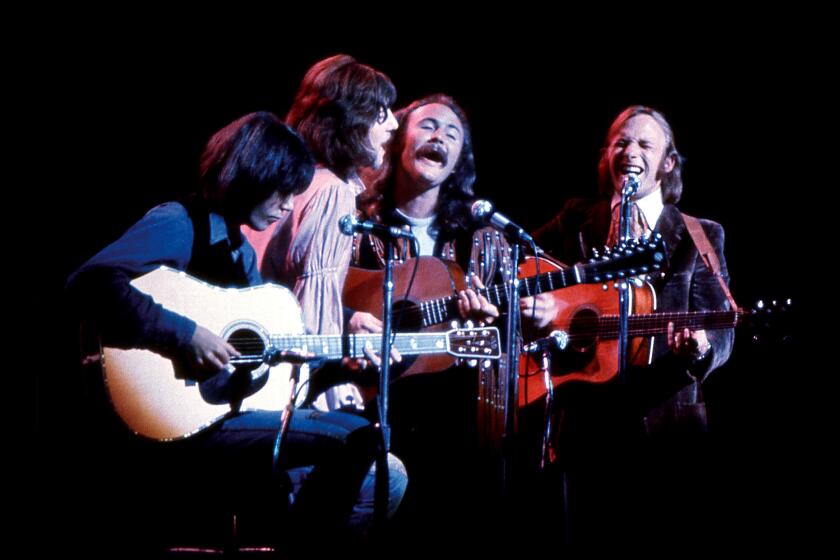Appreciation: Remembering Saafir, California’s avant garde rap innovator

- Share via
Hip-hop fans around the world were shocked this week to hear the sad news that one of California’s all-time great rap innovators, Saafir, died Tuesday morning. As reported in an Instagram post from longtime friend and collaborator Xzibit, Saafir “The Saucy Nomad” passed away surrounded by loved ones. He was 54.
Xzibit was one-third, along with Saafir and Ras Kass, of California rap supergroup Golden State Project, originally named “Golden State Warriors” until a cease-and-desist filing from the NBA team forced them to change, beginning a series of internal industry-based issues whose years-long delays made the Golden State Project album second only to Dr Dre’s “Detox” in terms of anticipated West Coast rap albums that never were.
But Golden State Project and the handful of lauded singles we did get from the trio, such as “3 Card Molly” and “Plastic Surgery,” were just one chapter in one of California’s most compelling rap careers. An Oakland native, Saafir — born Reggie Gibson — debuted on Digital Underground’s 1993 B-side “Carry the Way” from the album “The Body Hat Syndrome.” Over an infectiously luscious funk production, Saafir’s verse was unlike anything in hip-hop at the time. A polished fully-in-control confidence over a truly unpredictable avant garde flow, Saafir was like a glitch in the rap soundscape that listeners couldn’t turn their head from. It became one of those monumental career-making verses that landed Saafir a deal with Quincy Jones’ Warner Bros imprint Qwest Records.
The next year saw Saafir make two absolutely monumental memorable contributions to hip-hop. One was his debut, “Boxcar Sessions,” an incredibly left-of-center release that was still definitely rooted in hip-hop, though it still sounded well ahead of its time. The single “Light Sleeper” arrived with a music video boasting a floating disembodied head arriving about halfway through, creating a visual that had no aesthetic father in the culture at that point. The track’s production, and the more traditional but equally stellar B-side “Battle Drill,” were undeniable head-nodders that helped the more skeptical listeners be welcomed into such a different approach to rap.
Saafir’s other big moment in 1994 was being the catalyst for one of the greatest rap battles of all time as, after Hieroglyphics member Casual allegedly no-showed a recording session for Saafir’s album, the tension escalated into an on-air battle at KMEL’s soon-to-be world-famous Wake Up Show, a 12-round back-and-forth that began as Saafir vs. Casual and escalated into Saafir’s crew Hobo Junction taking on all of Hieroglyphics. It’s a battle every hip-hop historian has either tape-traded, downloaded or streamed and, in a sad coincidence, its 30th anniversary was exactly one day before Saafir died.
While Saafir’s 2006 indie comeback album, “Good Game: The Return,” made him a sentimental favorite for underground rap fans to root for, his highest-profile appearances around the turn of the millennium were in front of the screen with cameos in 50 Cent’s “Many Men” and Mya’s “My First Night With You” videos. Saafir’s dynamic camera presence didn’t come as a surprise to longtime fans, as prior to his rap notoriety he played Harold in the 1993 film “Menace II Society.”
In recent years, Saafir’s health issues had come to light. In July 1992, Saafir was among those injured in the crash of TWA Flight 843 after an aborted takeoff, beginning a decades-long series of spine problems that were not known to his fans for years. Further issues included a spinal tumor removal in 2005 and related leg problems, resulting in Saafir using a wheelchair for most of the last decade. His last high-profile appearance rapping was on Prince Po and Oh No’s 2013 track “U Already,” where he proved that despite his challenges, his lyrics and flow were as definitively refined as ever. Three decades of boundary-pushing rappers who have praised the influence of “Boxcar Sessions” have turned the album into one of the genre’s most passionately embraced cult hits, a not-so-secret society that today mourns a one-of-a-kind loss.
More to Read
The biggest entertainment stories
Get our big stories about Hollywood, film, television, music, arts, culture and more right in your inbox as soon as they publish.
You may occasionally receive promotional content from the Los Angeles Times.











